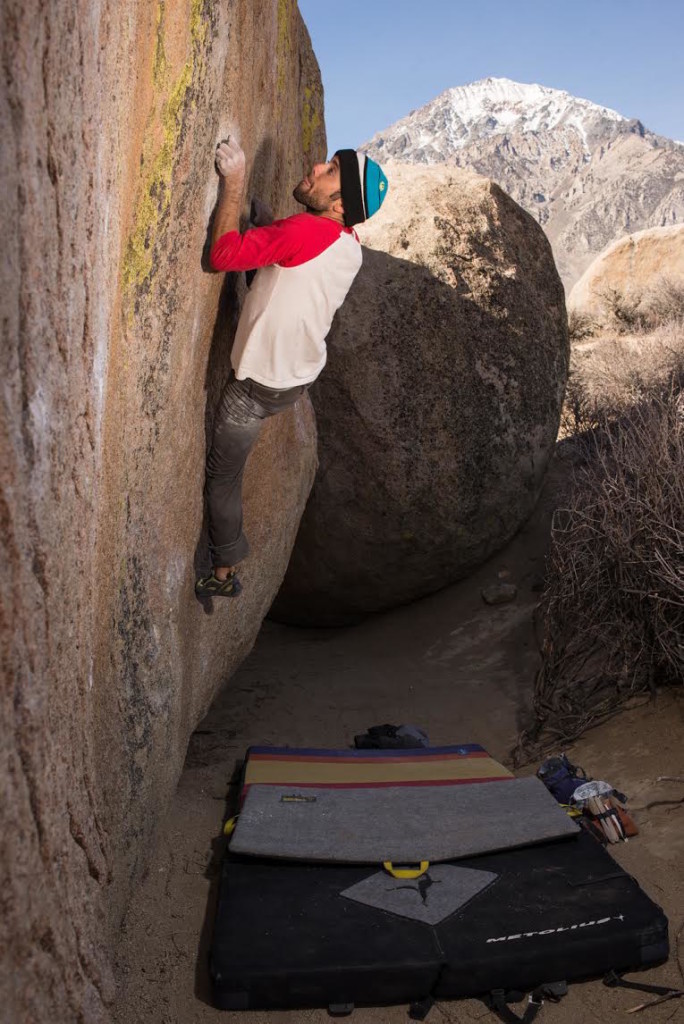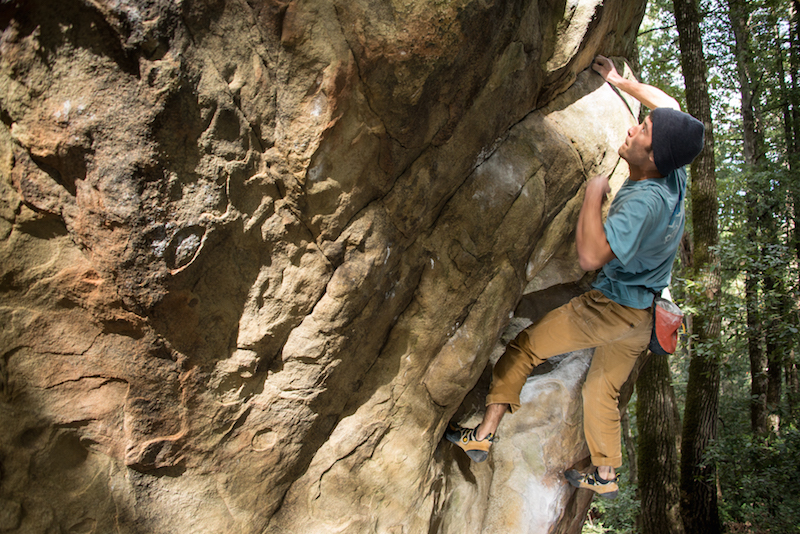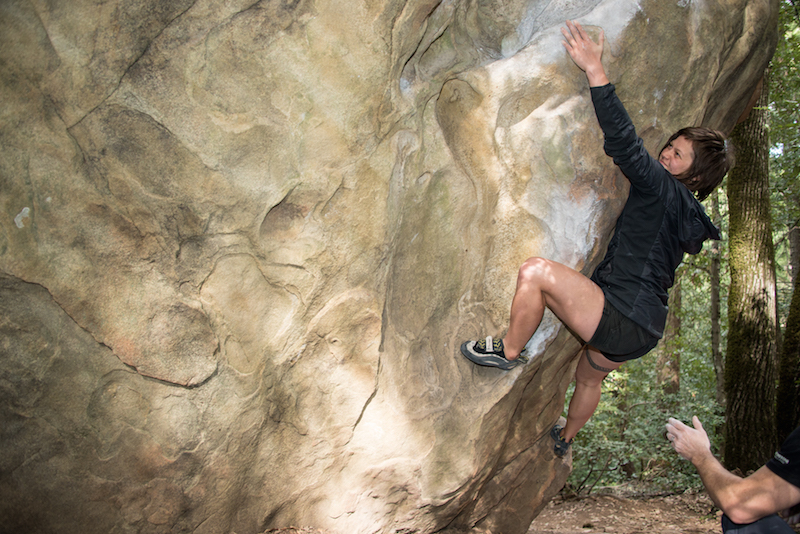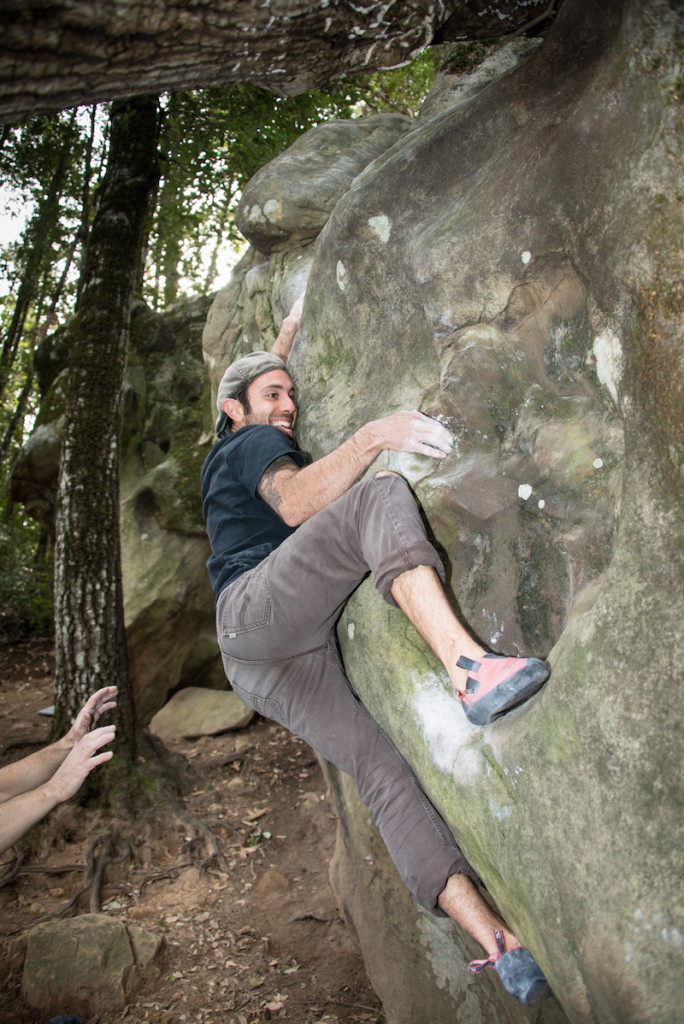 I wrapped my left thumb and index finger around the razor-sharp, Buttermilk gaston and pulled up onto my right foot.
I wrapped my left thumb and index finger around the razor-sharp, Buttermilk gaston and pulled up onto my right foot.
Nope.
That’s not the move.
With a thud, I’m back on the pad.
Cursing, I notice an aching pain in my left index finger.
Split…. Badly.
My first day in the high desert is off to a great start…
After a few unsuccessful attempts to tape the tip and keep climbing, I come to the frustrating realization: it’s time to let go.
I run through all the steps it took to get out to this problem–time off of work, money lost, 8-hour drive, shitty washboard-ed roads messing up my suspension, lugging heavy gear, wrangling my rowdy pup. And for what??
F*ck this sport.
Everyone who climbs has had to face failure head on. It forces us to confront our darker side, and then learn how to forge onward. In a sport where failure is more common than success, how can we stay motivated to keep going?
While physical training gets a lot of attention, it’s important to focus on the mental and emotional side of your climbing. The climbers that become the most aware of their strengths and weaknesses, both mental and physical, are those that get injured less, stay more psyched, and ultimately make climbing a lifelong pursuit.
When Things Go Right: Flow State
What’s actually going on inside of you when you’re having a good session in the gym, or cruising up the classics at your favorite crag? What’s happening inside your mind and body?
You’re in a state of flow.

Flow is a holistic attunement of earth, body, and mind. It is explicitly intuitive. If you’re in flow state, there are no thoughts racing through your head, no doubts poking at your psyche, no distractions, just sensitivity, intuition, and movement. You’re totally present. You look to the next hold and feel it before you touch it, your body knows what it needs and transitions quickly from one move to the next. You’ve let go and completely trust your intuition. Faith, trust, and confidence: this is pure climbing.
When Things go Wrong: The Breakdown
In my experience, climbing is most difficult when we experience a breakdown – when something snaps you out of your flow state, and you’re suddenly you’re trying over and over and over and…. failing.
Understandably, we’re vulnerable in this space of failure, of not being good at something. For most, a sort of reptilian response is triggered, a thoughtless outburst of frustration that we can’t control.
Current us can’t do it. But we desperately want to do it. NOW.
So, what’s the most efficient way back to flow?
Attachment and The Art of Letting Go

When we get stuck in this state of failure, of repeated unsuccessful attempts, of throwing wobblers and vowing to quit climbing forever… It’s time to focus on the art of letting go. I am by no means a master, but I believe in its power.
When you begin to fail on a climb or boulder problem, first run through a quick mental and physical check-up.
- Are you hydrated? Drink water.
- Is your energy low? Eat something.
- Have you been resting enough? For most climbers, the answer is a resounding no. Sit down, take your shoes off, chillax.
If you’re hydrated, fed, rested and still stuck, then it’s time to get rid of your attachment and let it go.
Sometimes we’re too attached to our beta. We’re still using a sequence that we’re convinced will work, even though it’s not. Sometimes we’re attached to the grade. Sometimes we’re just attached to solving the damn puzzle and can’t fathom walking away until it goes down!
Letting go is the art of noticing our attachment, and saying goodbye to it. The rock will still be there, the climb will still be there, and chances are there are countless other puzzles that will be just as joyous to solve.
Why not step away and find a different problem? The negative headspace that arises in these moments of intense attachment is anti-flow. Doubt, fear, frustration, anger – all those normal human emotions that bubble up when confronted with failure, are getting in your way.
Often, you can save a session from disaster by realizing you’ve become too attached. Bring it back to why you got you hooked on climbing in the first place: IT’S SO MUCH FUN! Play, laugh, fall down, laugh some more, trust yourself, listen to your body, let go, and start over.
To me, climbing at its best is a meditation. Be in the moment and work on being ok with letting go.
Living in Flow
 The tools I use to reset myself at the crag are the same tools I use in life. When we notice road rage bubbling up inside of us, impatience in the checkout line, or crippling nerves over an upcoming date – we’re too attached to something.
The tools I use to reset myself at the crag are the same tools I use in life. When we notice road rage bubbling up inside of us, impatience in the checkout line, or crippling nerves over an upcoming date – we’re too attached to something.
We can let our psyche fill with anger, fear, and frustration… or we can acknowledge our attachment and let it go.
Reset. The road will still be there. Your destination will not disappear. You don’t win a prize if the cashier checks you out faster. You (probably) won’t die if your tinder date ends up being a bust.
Become unattached. Breathe. Come back to the present.
Think about using this tool the next time you notice yourself getting aggravated. Whether at the gym or out in your world, realize what you are attached to and consider letting it go.
Life is a like a v-impossible boulder problem. You may not send it every time, but if you become aware of your attachments and learn when to let them go, you can get back to what’s important.
 By Alex Hocevar-Smith
By Alex Hocevar-Smith
Photos By Andrea Laue. Follow her on Instagram for more wanderlust-inducing shots.
When not behind the front desk at Dogpatch Boulders, Alex can be found on the mat, sharing his words of wisdom and ephemeral psych. If you’re interested in taking a private lesson from Alex, call the front desk or book a session online.

